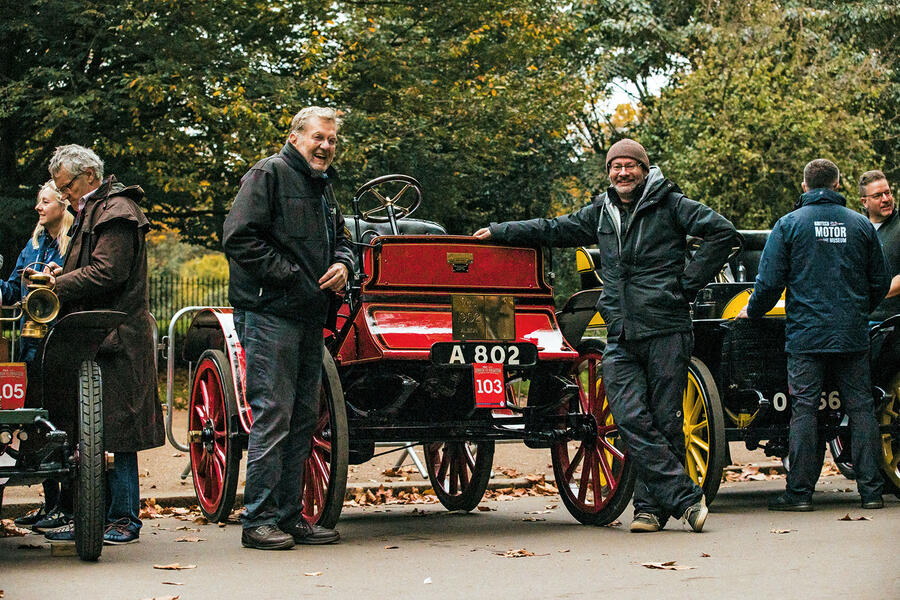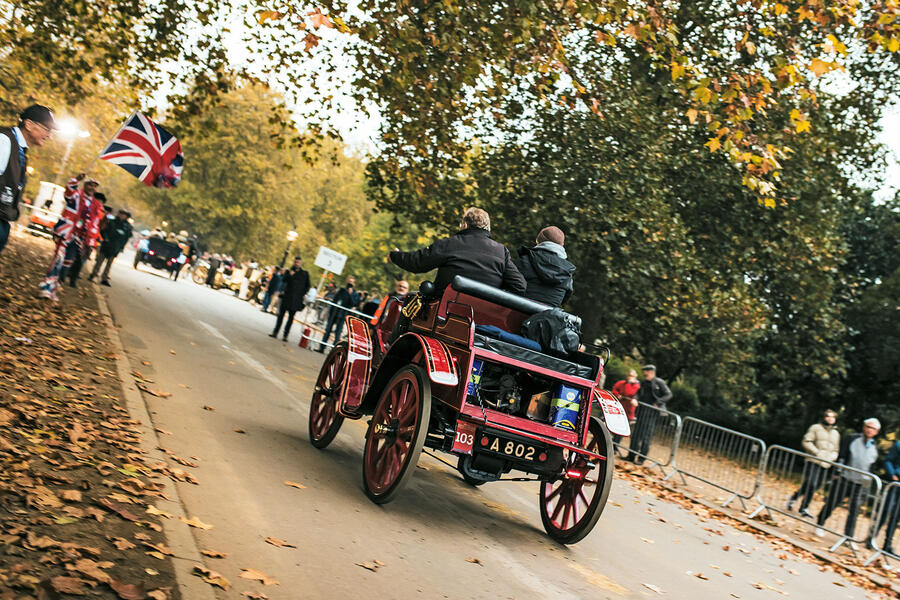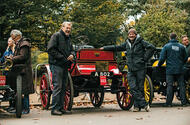How did Prior and Cropley fare when they attempted the 54-mile rally in a 1902 Albion?
Before there were coupés and SUVs, one of the early car bodystyles was the ‘dog cart’. It was so called because when horses pulled carriages, you might keep the dogs in the middle.
In the new horseless era, when this 1902 Albion A1 was made, it was where some makers put the engine instead, without seemingly much changing the design otherwise.
Of the 369 cars that started the annual London to Brighton Veteran Car Run on 3 November, the Albion is among those that most looks like a hangover from the pre-engine combustion era.
It wouldn’t look that out of place with a nag tied to the front of it.
Steve Cropley and I will be driving what is one of seven surviving dog carts, I’m told by a man who owns one.
His will do 28mph, a fact that makes Cropley, my co-pilot for the day, and who nominated us to drive it, even more apologetic than he already was.
He feels like he’s stitched me up by getting us to drive a car that will do no more than 18mph flat out, and that will slow to a crawl, at best, on an incline. I’m not fussed.
Given that making the journey is the whole point, the longer it takes, the more time there is to enjoy it, I think.
It’s a journey as well trodden as perhaps any in early motoring. I’m sure you know the story, but until 1896 it was a requirement that cars were limited to 4mph and accompanied by someone walking in front of them waving a red flag.

When the Locomotives on Highways Act was passed, speed limits rose to 14mph, so a group of early motorists gathered on the first Sunday in November to drive from London to Brighton, unaccompanied, in celebration.
A run was made annually until 1902, then reintroduced to mark the anniversary in 1927, for pre-1905 cars, and the tradition has been running mostly every year since.
While I’ve been to the finish before, I hadn’t appreciated the scale of it. There are lane closures in central London and on the approach to Brighton, one-way systems introduced on some South Downs inclines, and comprehensive marshalling throughout. Total spectators number tens of thousands.
A feature of early cars is how many different ways their makers found to do things before anyone settled on three pedals and a lever or two. I once raced against a car whose drive was engaged by pulling the entire back axle rearwards until it tensioned a drive belt.
The Albion is part-familiar, part-wacky. The engine’s a water-cooled flat twin, mounted north-south in the chassis with a chain driving the rear axle.
Other than a total-loss oil lubrication system and the fact that the water needs topping up every 15 miles, it’s not so outlandish.
But controls take a moment. It has an upright steering wheel – most dog carts had tillers – offset to the left of the driver.
There is a hand throttle, with a ratchet to stay its position, and two big levers next to each other. The left one’s a gearlever (second to neutral to first to reverse, with a couple of false neutrals thrown in).
There’s no synchro, of course, and straight-cut gears, so there will always be a graunch of some kind. It’s better on a closed throttle. The right-hand lever is a brake that pulls a shoe onto each rear wheel.
The foot pedal is the odd one. The first part of its movement disengages the clutch, but the rest of its travel begins to push a brake against the transmission.

In my early practice, it’s not wonderfully clear where one of those functions begins, or when the other does.
I’m worried that downhill one could try to downshift to first for some engine braking, but find oneself in a box of neutrals, with two overwhelmed brakes, and steering that feels nervy at 18mph on the flat.
Cropley tells me that the red flag act had a real effect on the advances of British car makers. Given more freedom, the French, Germans and Americans in particular started bounding ahead. And of cars ‘our’ age on the run that come past us, most are foreign-manufactured.
By contrast, the Albion really backs up its equine vibe by basically having defined speeds.
You can feather the throttle but most likely you will be driving at full whack in second, which eventually brings 18mph, or in first, which gives it the pace of a quick stroll, on the flat at least. They are like a horse’s canter or its walk.
London is where the Albion’s modest top speed is least problematic, because limits are 20mph and the city’s mostly flat.
It’s also a great buzz: leaving from Hyde Park, driving under Wellington Arch, past Buckingham Palace and along The Mall to emerge onto the public road at Trafalgar Square is the kind of thrill you can only get on the Veteran Car Run.
Past Downing Street, left across Westminster Bridge. What a hoot.
It doesn’t get any less enjoyable, even if, as you get further south, it gets hillier and hillier. Cropley’s prepped to jump out and walk if needs be.Â

But in first gear, this might just be the unstallable engine. Even on the sharpest inclines, where we see veteran cars parked by the roadside steaming, or with occupants pushing, the trusty Albion just keeps plodding along at walking pace, throttle wide open, as if pulled by a hearty mule.
The British Motor Museum, which owns the Albion, has entered six cars into the run, and while five of them make it, I doubt there’s any that instil such confidence in museum techies as the Albion.
The ride’s surprisingly good, considering the solid tyres and wooden wheels too.
They make some noise, as does gear whine, so engine noise is very much third place to those, a gentle and lightly comedic phut not unlike videos you might have seen where someone puts a rubber glove on an exhaust and cuts a hole in one finger.
It is, by any modern objective standards, pretty dismal, quite hairy, and very involved to drive, but that is all part of the fun: cooking on a campfire is less easy than a microwave; sending a postcard less convenient than a WhatsApp; sailing slower than powerboating. But that’s not really the point.
At 2.40pm, about seven hours after setting off, we cross the finish line on Madeira Drive, Brighton. By 2.50pm I’d happily hop back on and do it all again in the other direction.Â




